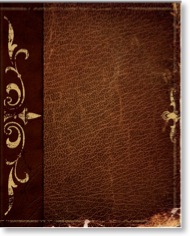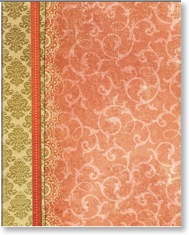Review: Holy Bible: Mosaic (NLT)
This review has been relocated here:
http://thislamp.com/?p=182
Please continue any further discussion at the new location.
HCSB Minister's Bible to Receive Updated Text in Early 2010
This post has been relocated here:
http://thislamp.com/?p=1315
Please continue any discussion at the new location.
First Look: Zondervan's NoteWorthy Bible
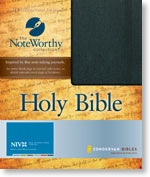
The official Zondervan description reads as follows:
Bible users, take note! With its unique design featuring blank right-hand pages, this Bible offers plenty of room for note taking. An accordion pocket inside provides added storage for loose notes. And an elastic band provides closure so you can keep everything securely in place.
Here are Theophrastus’ comments on the NIV Noteworthy Bible:
(a) Don't use this edition for taking notes. The bleed-through on the paper is so bad I can see down three pages. Since this is not a true interleaved edition (with a double-sided blank page of paper between each double-sided printed page of paper) your ink marks will mar right through the other side.
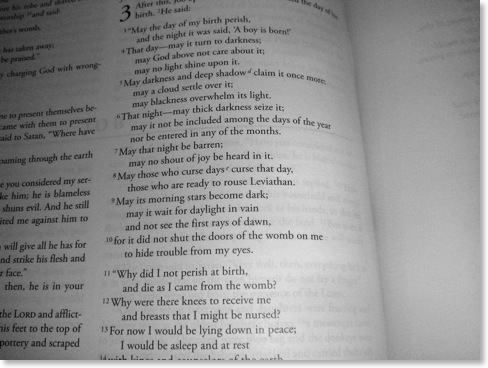
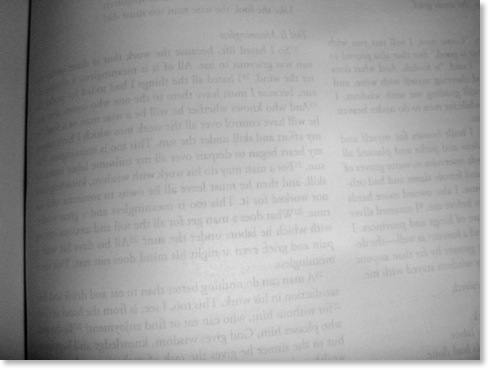
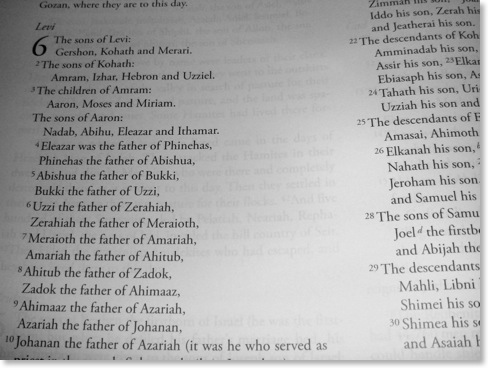
(b) Tiny font. The font size of the Little Oxford Bible is just five point, but the font size of the Noteworthy NIV appears to be slightly smaller than that. Thanks to my near-sightedness, I can read the Little Oxford Bible without magnifying glass, but I can't say the same Noteworthy NIV.

(c) Relatively generous inter-line spacing. Double column. Square size.
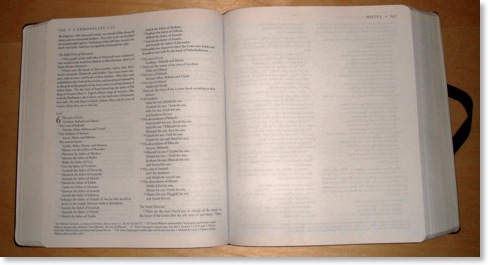
(d) Binding claims to be bonded leather but feels like slightly stiff paperback to me. No one would confuse this with a moleskin notebook.
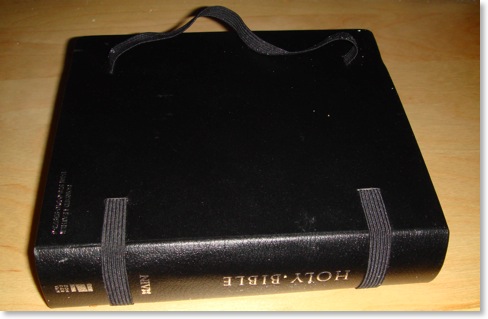
(e) The elastic on the the outside binding makes it look like this binding is designed to fail! It also give the bible a slight fetishistic look -- maybe it is designed for folks who like to wear latex and elastic.
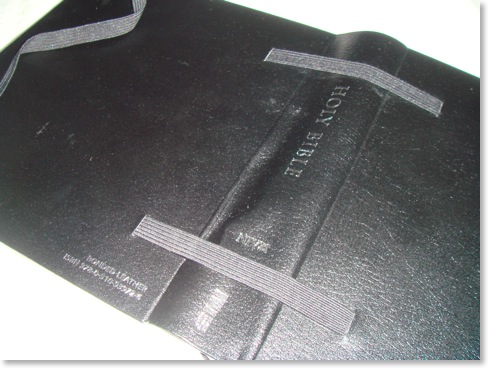
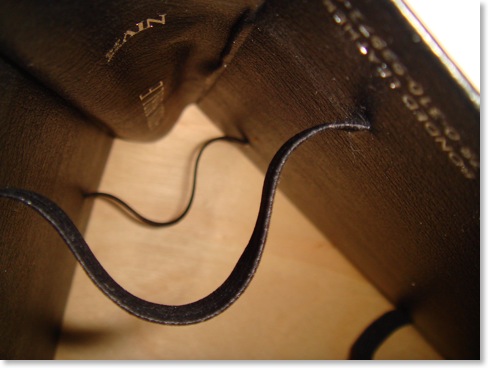
(f) The internal paper pocket on mine is already failing and I haven't put anything in it.

(g) The left top margin has the page number, an ugly 4-fold diamond mark, the book, name and chapter/verse, but the right top margin only says "notes", the diamond mark, and the page number, making it somewhat more difficult to find sections than one might desire. On the other hand, bleed-through on the Bible is so bad that one can simply read the mirror-image of text on the next page.
(h) No bonuses (no maps, no concordance, no cross-references, no book introductions) except for a half-page table of weights and measures.
All-in-all, I can see no use for this volume except as a fashion accessory among the Goth set.
Sometimes You Just Can't Go Back...So Much for the NASB

And such is life.
Kathy sat me down on the couch this morning, and in no uncertain terms told me, “You can’t teach with whatever translation you’ve used the last two Sundays anymore!”
“Why not?” I sheepishly asked. Although I knew better. I had read the word “booty” from that Bible in front of forty people in our Bible study to the snicker of some and to the red face of my wife. Who uses that word anyway--pirates?
She went on to tell me that every time I read anything from my Bible, it was hard to understand and too different from anything anyone else was reading from. She said, “No one could even follow you!”
I reached for the Bible to which she was referring. I opened it up and showed it to her. “But I like this Bible. It has wide margins. I teach better when I use it.”
“Better for you, maybe, but not for anyone else. So you have to decide--are you going to teach in a way that’s easier for you or easier for those listening to you?”
Here’s what happened: two weeks ago, I did the unthinkable--I went back to my NASB for teaching our Sunday morning Bible study. I taught from the NASB for almost two decades, and then in 2005, while teaching a half year study on Romans, I realized I was spending more time explaining the English of the NASB than explaining what Paul actually said in Romans. I have always been an advocate of modern language translation, but I always felt that in a teaching setting, I would be able to use something a bit more formal. I quit doing that in 2005.
Since then I’ve used a variety of translations--going first to the HCSB and then the TNIV as my primary teaching Bible, but also using the NLT quite a bit and even the NET Bible.
...But I was frustrated. Part of my method all those years involved taking notes in a wide margin edition, and then using that edition when I’m teaching. I carried notes on paper, too, but the subset in my margins were little reminders of the most important information to get across.
Two decades ago, my goal had been to study biblical languages to the point that I no longer needed translations at all. I always carry at least my Greek New Testament with me, but I have two problems with totally abandoning English translations: (1) I simply don’t have every word in the NT in my working vocabulary. Yes, I can prepare a passage beforehand to teach from. But the first time I think of another passage to look at, or the first time someone says, “What about this verse?” I look at that and can translate everything except those two words. So it’s never been practical on the fly to try do that exclusively--at least not yet. And (2), I’m hopefully a bit humbler now, but I recognize that my “on the fly” translation, even if I know every word, is not necessarily better than a standard translation produced by a committee made up of people who are surely smarter than me.
So I continue to use both, using a translation as a primary text when I’m in front of others.
After abandoning the NASB, the translation I’d used since I was thirteen-years-old, I assumed I’d be able to get one of these more modern translations in a wide-margin edition. No such luck. So I thought I’d be patient and wait, but now after three and a half years, still no luck.
Sunday before last, I did what I had been tempted to do many times before, I taught from my trusty old Foundation Press wide-margin NASB. It felt good. I felt like I was spending time with an old friend. And even teaching from Isaiah 38-39, I managed to get away with it, partly by letting people in my class read sections that were...what can I say...a bit awkward sounding. But I made it, I felt like I was a better teacher, and I planned to go on and use my trusty NASB for a second week.
Then this past Sunday, we were running short of time as is often the case. With only a couple of minutes to go, I offered to read vv. 11-12 of Isaiah 53. As I begin to read...As a result of the anguish of His soul...I can already see it upcoming in v. 12 in my peripheral vision. My Servant, will justify the many, As He will bear their iniquities... This is what I noted in my preparation that I absolutely must not read publicly...Therefore, I will allot Him a a\portion with the great... I tried to think of all the other translations that I looked at ahead of time. What word did they use for שָׁלָל? Spoil (HCSB, ESV, JPS, NKJV, NRSV, REB), spoils (TNIV, NET)...it was right there swimming about my brain, but I couldn’t remember. And then I read it... aloud:
And He will divide the booty with the strong
I heard chuckles. I could see heads lifting up, including my wife’s. I knew what they were thinking. Did he just say... ? Surely not. No one except for teenagers and pirates say that.
So, the heart-to-heart talk this morning came as no surprise. She had all the conviction of Sarah telling Abraham that Hagar had to go, so who was I to argue with her?
So, I’ll go back to my non-wide-margin Bibles, and wait hopefully that one day, I’ll get a wide margin Bible in a modern translation. But what do I use this Sunday? For the last couple of years, I’ve used TNIV on Sundays mostly, and the NLT during the week. But sadly, I have doubts about the staying power of the TNIV. So maybe this is simply the time to switch.
I use the NLT with my college students midweek because not all of them are believers, and the NLT has the most natural conversational English of any major translation. As I used it tonight with a class, I had to ask myself why I couldn’t use it on Sunday mornings, too? And I don’t have a good answer for that. So maybe this is the crossroads in which I simply need to make the NLT my primary public use Bible. I may have been held back by nothing more than my own traditionalism, but after listening this past week to Eugene Peterson’s Eat This Book, I’m more convicted than ever to present the Scriptures in common, ordinary language, and not the language of heavenly-portals-loud-with-hosannas-ring.
But what do I use? There’s still no wide-margin NLT. I’d certainly want the 2007 edition. So what are my options?
NRSV Notetaker's Bible
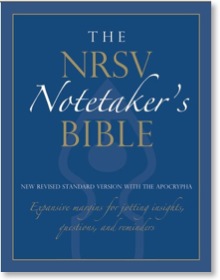
Product Description
Perhaps you're one of those studious, deliberate readers who likes to underline phrases, create outlines, list cross-references, etc. Now you don't have to resort to cramped lettering or words in the gutter. This single-column text, with 2-inch wide-ruled margins, allows you ample room for making all manner of notes. 1632 pages, hardcover. Oxford University.
Publisher's Description
The Notetaker's Bible offers the perfect format for students of the Bible who wish to make their own notes--whether scholarly notations or spiritual insights--rather than rely on the words of others.
Some wide-margin Bibles have only slightly larger margins on both sides of the page. And writing in the gutter is nearly impossible. In The NRSV Notetaker's Bible, we've eliminated those frustrations by giving you an extra-wide, two-inch outside margin. And because the text is a single column, your notes are always right beside the relevant passage. Moreover, we've added rules make it even easier to keep on track. For more expansive thoughts, you can turn to the back of the Bible for additional ruled pages.
In addition, this is the only available wide-margin Bible to feature the highly-regarded New Revised Standard Version translation, the preferred translation in most academic settings, as well as many churches and homes. So whether you're a student or professor, pastor or lay person, The NRSV Notetaker's Bible will fit your Bible study needs. Its open margins are a perfect match for your open mind.
The NRSV Notetaker's Bible is available in hardcover as well as in deluxe cloth and bonded leather, ideal for presentations and gift giving.
Here is a view of a page spread (click image for actual size):
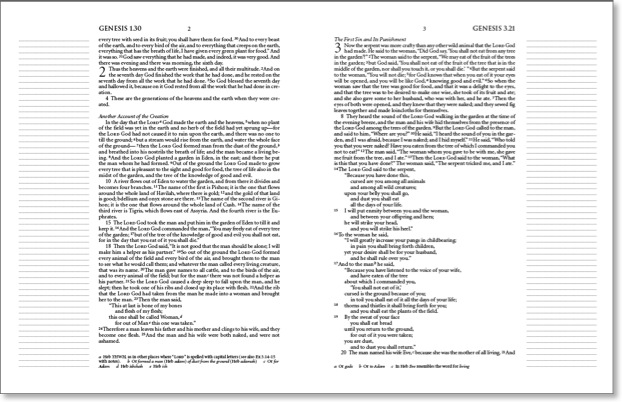
I’d prefer a page without the ruled lines, but maybe that’s just me.
HT: Jay Davis
New Journaling Bibles on the Horizon (HCSB, NRSV)
There are two new editions in the HCSB, called the HCSB Notetaker’s Bible, set for release very soon (October 8). One is referred to as a Men’s edition (ISBN 158640475X) and comes in a decorative brown hardcover. A women’s edition in mauve/olive green is also available (ISBN 1586404768).
There are no page spreads available for viewing yet, but these images of the covers are available at the CBD website (click on each image to see each Bible’s respective page):
Really, B&H should have probably avoided calling these “Men’s” and “Women’s” editions. I’m certain there will be some women who want the brown, and you never know who might want the other edition as well.
The CBD website also includes the following ad copy:
In an age when people can take notes using a variety of electronic media, there has emerged a countertrend whereby people want to journal in their won handwriting. The Notetaker's Bible features wide margins with subtle ruled lines, helpful center-column cross references, a concordance, and best of all, the largest point size among all Bibles of this kind. Handsomly bound for a man's taste. [The women’s edition says “Beautifully bound in with a woman's taste in mind.”]
Features include:
- The largest point size among Bibles of this kind
- Easy-to-navigate center-column references
- An easy-to-use concordance
- Ribbon marker
- Words of Jesus in red
- Translation footnotes, and exclusive HCSB bullet notes
Both Bibles measure 9.38 x 7.25 x 1 and contain 1280 pages. Biblical text will be presented in double columns. Personally, I feel that if a Bible of this sort uses double columns of text, there should be equal amounts of spacing for written notes for each column. We will have to see if B&H Publishing thought of this.
While I was on the CBD website, I also noticed an NRSV Notetaker’s Bible (ISBN 0195289226) to be released from Oxford University Press in 2009. There aren’t a lot of details yet, and no image that I could find even of the cover. But according to the CBD site the Bible will be paperback, contain 1296 pages, and measure 8 x 6.3 inches.
Worthy of Note 01/30/2008
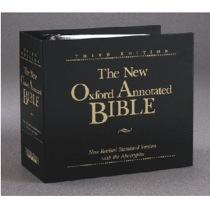
Says Iyov:
So, with all that extra page space, there is plenty of room for making ample annotations. The paper is significantly thicker than typical Bible paper, so there is much less bleed through from a pen. And, I can add extra paper anytime one wants (in the fashion of Jonathan Edwards' Blank Bible). If I make a mistake, I can always remove the page and replace it with a photocopy from my bound edition of the NOAB. If I want to slip in an entire article, or a copy of a page in original languages -- there is no problem. It seems to me that this is the ultimate in flexibility.
I'm glad to see this finally released, although I doubt I'll personally buy one. Regardless, I've got a number of larger blog projects I'm working on, one of which is an update to last year's survey of wide-margin Bibles. I'm glad that I'll be able to include an entry for the NRSV this year.

But we find ourselves at a point in history when we've never had so many choices, and yet the options are mostly arrayed along a horizontal spectrum -- a thousand different flavors of the same basic thing. I'd like to see more vertical choices, and that might require a shift in perspective. Instead of speaking to end-users as consumers, we might have to start thinking of them as readers.
What is most significant in the post is Bertrand's five-point "Starting Points for Marketing High-End Bible Editions." I can only hope that publishers will pay attention.


My esteem for White dropped significantly a few years ago due to the way he handled a theological disagreement with another individual whom I respect very much. I felt his approach to the issue was uncharitable, far too public, and lacking in the kind of collegiality that should characterize Christian scholarship. Nevertheless, White is usually in natural form when he is engaged in formal debate. However, I often believe that White is rarely pitted in his debates against opponents who are equally skilled. At the very least, Ehrman should provide a worthy opponent to White and this is a subject in which both are well-versed.
Christianity Today has released its list of the "10 Most Redeeming Films of 2007." Some entries on the list may surprise you, but it's a very good list. I remember when we used to do more movie reviews and discussion around here.
Finally, in the I JUST DON'T GET IT DEPARTMENT: 2008 marks the 30th anniversary of the New International Version of the Bible. I've seen references on two other blogs (see here and here; oh, and also here) that Zondervan is planning a special wide-margin, high-end leather edition of the NIV Study Bible as one of the many ways that the NIV's 30th anniversary will be celebrated.
This is in spite of the fact that so many of us have asked for one decent wide-margin edition of the TNIV (the so-called TNIV Square Bible is flawed in three areas: (1) it's paper is too thin for annotations because it is a thinline, (2) the user doesn't have wide margin access to the inner column of text, and (3) the binding is subpar). If the TNIV is truly an improvement to the NIV (which I honestly believe it is), then why does Zondervan (and IBS, Cambridge, and Hodder) keep pushing the NIV and publishing new editions? If in ten years the TNIV turns out to be an also-ran translation, it will only be because publishers didn't know how to fully transition away from the NIV.
My suggestion for celebrating the NIV's 30 year anniversary? Retire it. (My apologies to everyone I just offended, including my friends at Zondervan.)
I would like to find simply ONE decent wide-margin, high quality (see Bertrand's post above for the meaning of high-quality) Bible in a contemporary 21st century translation (HCSB, NLTse, TNIV, or NET). I'm still writing down notes in my wide margin NASB95, but the first translation of those I've listed that is released in a single-column, non-thinline, wide-margin edition, I will make my primary translation for preaching and teaching for the next decade. You heard it here first.
Forthcoming Wide-Margin Bible Survey Update
Here's where you can help me. Take a look at the original post linked in the above paragraph. If you know of any new wide-margin Bibles that have been released, please leave the information in the comments below so I can include it.
Also, although I opted not to include KJV offerings last time, I occasionally get emails asking about KJV wide-margin Bibles. I still don't recommend the KJV as a primary study Bible, which is why I didn't list them last time. However, I am considering adding them to the new survey, so if you know of some specific KJV wide-margins out there, please let me know--especially if you can give descriptions of them.
Bible Note-Taking: My Method
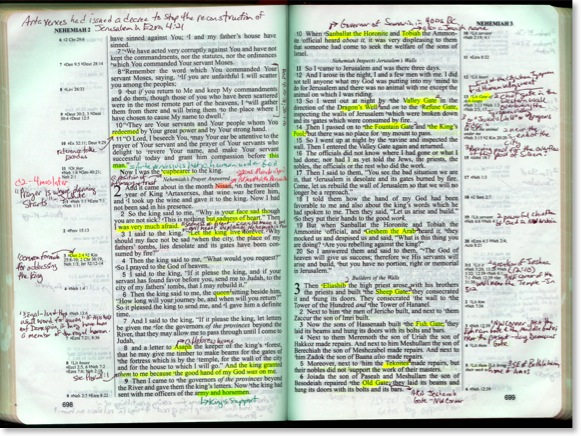
I actually developed it while I was in college, and although I've tweaked it along the way here and there, it's not overly changed from the way it was years ago. I have to admit that the actual structure is based on the colors available in a pack of Stabilo Boss Dry Highlighters. The pack came in five colors. I never figured out what to do with the orange, so I used it elsewhere. However, here is how I arranged my categories:
YELLOW = General and miscellaneous notes that do not fall into other categories.
RED = Dates, chronology, date of composition
GREEN = symbolism, metaphor, literary features
BLUE = Messianic, Christological
With each of the dry highlighters, I use a corresponding pen for my annotations with the exception of the first category for which I use a black pen. In other words, I highlight in yellow, but the corresponding note is in black, unlike the other colors for which I have matching highlighter and pens.
The main Bible I take notes in is a NASB wide-margin single column reference Bible from Foundation Publications. I would be willing to use a more contemporary version such as the TNIV or NLT, but no adequate wide margin Bible is available in these translations. I make these annotations whenever I study a passage (using commentaries and other reference works) for personal edification or teaching others. I make different kinds of notes in a Greek NT, usually grammatical issues relating to the Greek text or a gloss of a rarely used word that is not in my memorized vocabulary.
Here are some random examples of the kind of annotations I've got marked in my NASB wide-margin Bible:
GENERAL AND MISCELLANEOUS NOTES
- In Gen 45:4, I have the word alive highlighted in yellow. In the margin I have the words "meaning 'enjoying health and well-being.'" I have no idea where I got this information--probably from a commentary. I will list a source for extended notes, but not short comments like these.
- Sometimes I merely write annotations without highlighting anything specific. For instance, In the top margin above 2 Sam 13, I have "reminder" bullets: • Absalom and Tamar were David's children by Maacah, daughter of the king of Gesure; and • Amnon Was David's son by Ahinoam, the Jezruelitess.
- At Neh 4:3, I have highlighted in yellow the words "break their stone wall down." In the margin are the words, "Actually archaeological discoveries have revealed Nehemiah's wall to be four feet thick--NAC." In this case, I did note the source: the New American Commentary. I could have just as easily noted the author instead of the series, but more than likely, the series would make a more familiar reference in this case.
- At Neh 3:13, Zanoah is highlighted in yellow with the accompanying note, "13 mi. sw of Jerusalem."
- Sometimes the notes will reflect alternate translations. In Neh 5:7, I highlighted the words "I consulted with myself" and in the margin have the note "lit. 'my heart took counsel upon me.'"
- Certain books like Job are heavily annotated. In this case, I was doing personal study through Job at one point, and then I've taught the book a few times.
- In many places throughout the Bible, I'll highlight a word in yellow, and in the margin or very close to it, write the actual underlying original language word.
DATES AND CHRONOLOGICAL ISSUES
- In Jer 1:2, I highlighted in red the phrase, "the thirteenth year of his reign." The corresponding note (written in red ink) says 627 BC.
- I highlighted in red the Hebrew month "Nisan" with the corresponding note "spans March-April; 1st month of the Persian year." Similarly at Neh 9:1, I highlighted the phrase "the twenty-fourth day of this month" with the annotation "Oct 30, 445 BC."
- I have a note in red at Acts 6 that these events occur five years after Pentecost.
- At the beginning of books, I often try to list suggested dates of composition. For instance in Matthew, I have a number of suggestions including on the more conservative side: "60's <70" from Carson, Moo, & Morris' NT Intro and "After 70" from Kümmel's more progressive NT Intro. Because these types of annotations come at the beginning of the book, I sometimes write other introductory notes in red as well such as suggested authors, but I don't do this consistently, it seems.
- I occasionally use red for brief outlines and structural notes.
SYMBOLISM/METAPHOR/LITERARY
- I highlighted "with fasting, in sackcloth and with dirt upon them" in green and my corresponding note written in green says "mourning and humility." This kind of note seems unnecessary after a while. I simply "know" that kind of information. Do I really need to make a note of it? And yet, I tend to add that kind of notation anyway for teaching purposes as it reminds me to mention it in an instructural setting.
- In Job 1:2 I have highlighted "Seven sons and three daughters" with the annotation "The symbolism of the numbers imply that Job had an ideal family." This kind of note gets a lot of play in a book like Revelation, where I have quite a bit of green.
- In Psalm 74:19, turtledove is highlighted with the simple annotation "Israel."
- A passage like Eccl 12:3-6 is loaded with symbols. "watchmen of the house" = arms, "mighty men" = legs, "grinding ones" = teeth, etc. I have all of these highlighted in green with accompanying annotations written in green.
- I use green for the many euphemisms in a book like Song of Solomon.
MESSIANIC/CHRISTOLOGICAL
- This turns out to be my least used color, perhaps because it could be overdone, especially in the gospels and become meaningless. Often annotations that could receive blue treatment simply get highlighted in yellow.
- Since the NASB wide margin that I use has a cross reference system, I often will highlight in blue the cross references between the testaments referred to in messianic prophecies. Surprisingly, often I find that the references aren't included both ways and I will have to write one of them in using a blue pen.
- In Rev 5:5, I have Lion highlighted in blue with an annotation written in blue that says "conquering warrior messiah." Then in v. 6, I have the accompanying Lamb highlighted in blue with the note "sacrificial death; links the Messiah to the passover lamb." I also have a note written in blue with v. 6, but not directly related to anything specifically highlighted, that says "Here John joins the OT Davidic Messiah and the Suffering Servant of Isaiah (Isa 52-53)." I really should have listed my source for that because I doubt it was my own original conclusion. It may have come from John Newport's book, The Lion and the Lamb.
Obviously, there are thousands of other examples, but the above are a sampling which I believe gives the flavor for what I am doing.
The actual Stabilo Boss Dry Highlighters are no longer made, but are still available on eBay. I have stocked up on enough to last for a very long time. The dry highlighters I usually see in stores these days are the Staedtler dry highlighters. To me these are a perfectly suitable replacement, except for the yellow pencil which makes me continue to seek out the older highlighters.
For years, I used ballpoint pens for my corresponding notes, with green ballpoints always the most difficult to come by. Noticing that some of my oldest notes were starting to bleed through, and I began to look for something else. A number of readers for this blog suggested the Pigma Micron pens. These are what I use exclusively in my Bibles now, and having experimented with different nib sizes, settled on a 01 point for writing in my Bibles. I like these pens so much, I use the larger nibs for grading papers and writing in my Moleskine journal.
I also discovered that Pigma Micron has a brown pen. I like the color brown for a pen, having used brown ink the last couple of years in the Mont Blanc I carry with me everyday. I incorporated brown into my Bible notetaking recently (the first new color added since the originals) by using it as the color for notable quotations that I sometimes find room for in the top or bottom margins of the page.
When I was teaching out of the NASB in which I take notes, I could truly say this was my primary Bible. At one time, I was studying with this Bible, teaching from it, and occasionally preaching from it. I really feel there's great value in using the same Bible for both preparation and delivery. Because I have chosen to teach from a more contemporary version, I have to leave my NASB at home and rely on typed notes and any annotations I may have had room to write in the limited space of the Bible I've been using. Of course, I always taught from pages of notes as well anyway, but in conjunction with the annotations in my Bible. Obviously, not everything could fit into a Bible's margins. But not having the same Bible for both phases definitely has its drawbacks.
And every Sunday morning as I pack up my bag of books to take to church, I am often tempted to chuck the contemporary versions and go back to my trusty NASB instead. Again, I've been willing for two years to make a complete jump to newer translations. The publishers just don't seem to want to comply.
Making the Case (Yet Again) for Wide Margin Bibles
Although I've provided the link above, it won’t remain active after a few weeks, so I’ll include a screenshot below:
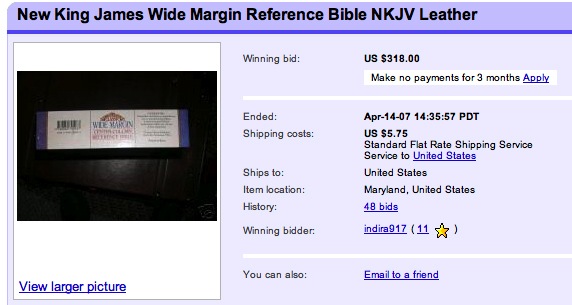
It boggles my mind really to think that someone would pay $318 for a wide margin NKJV--and a bonded leather one at that! But Larry summed it up quite well in his comments when he said this:
This must be proof positive that people are passionate about wide margin Bibles. More than $300 for a bonded leather cheapo Bible from Nelson? A NKJV?
And the fact that Nelson allowed this to go out of print while Crossway is publishing multiple note-taking Bibles may perhaps play some role in the NKJV's fall and the ESV's rise. (Certainly, there are other factors, but given the investment that publishers claim to make in new Bibles, why wouldn't they want to make their franchises available in every format that there is demand for?)
I think you put your finger on it a few months ago when you pointed out that while sales of wide margins may appear weak, they are sold to opinion makers -- and thus influence many more sales.
I've had representatives from three different Bible publishers tell me that wide margin Bibles just don't sell well. But it's that last statement made by Larry that I believe most Bible publishers just don't get. But Crossway gets it. They know that the teachers, preachers, and other serious Bible students want wide margin Bibles. And even if these particular buyers don't represent a large market, the fact is that this is the group that influences the purchases made by those sitting under their instruction. The fact that Crossway gets this is evidenced by the fact that they offer four different ESV Bibles with wide margins: The Deluxe Reference Bible, The Journaling Bible, The Single Column Reference Bible, and the Wide Margin Reference Bible.
But where are the decent wide-margin Bibles from the other 21st century translations (NLTse [2004], HCSB [2004], NET [2005], TNIV [2005])? Let's run through that list real quick.
New Living Translation
The original NLT1 (1996) had one of the best wide margin Bibles I've ever seen in terms of the Notemakers Bible. It had a healthy one and a half inches of space in the margins of a single-column text and two inches of lined space at the bottom for journaling. But since sells weren't that great, Tyndale has decided not to release an edition in the NLT second edition.
But why didn't the Notemakers Bible sell? The Living Bible and its inheritor, the New Living Translation have always been a bit of a populist Bible. While scholars put down the original Living Bible, Christians bought them in droves, and many testified that this was the first Bible they ever really understood. But these were probably not the kind of folks--for the most part--who would have been interested in a wide margin edition for their own notes.
The 1996 NLT wasn't that far removed from it's predecessor--especially in the public's eye--in spite now being called a translation rather than a paraphrase. Regardless, the top notch team of Evangelical scholars who produced the 1996 first edition reconvened to tighten up the translation, bringing it closer to the autographs and hopefully bring about the respect the NLT deserved. That resulted in the 2004 NLT second edition, which although quietly introduced was radically different than the first edition.
To gain even greater credibility, Tyndale has begun the Cornerstone Biblical Commentary Series, based solely on the NLTse. From the two volumes I have so far in the series, I can say that it's an excellent evangelical commentary series on the Bible. And I'm not sure it could have been based on the earlier NLT1 (let alone the Living Bible) without a great amount of work. But the NLTse is a different creature! And now that a commentary series is based on it, what would be a better match than an NLTse Bible with wide margins to study along with it and make notes? It seems to only make sense to me.
Holman Christian Standard Bible
There is only one wide margin HCSB Bible available: The HCSB Minister's Bible. So far it has received mixed reviews (see my review here). The main complaints stem from paper that is too thin and wide margins that really aren't that wide. Plus I've had more than one person email me who was not a minister saying they would like to use it simply to have a wide margin HCSB, but have been reluctant to do so because they feel funny carrying around something with that title on the spine. I'm really surprised there aren't more offerings here from Holman considering the HCSB is now the default translation in all of Lifeway's Sunday School curriculum. It would seem to me that a decent wide margin HCSB would be a perfect match.
NET Bible
I'm not totally surprised that the NET Bible has not seen a wide margin edition yet. Certainly with 60,000+ notes, one would wonder what could be added. Plus, the NET is still trying to gain the attention of the larger Evangelical world. Selling through more than merely mail order might help them out some. To me of all these Bible translations listed here that don't have wide-margin editions, the NET is the only one that gets a pass.
Today's New International Version
I would guess that the possibility of a TNIV Wide Margin Bible primarily suffers from the mixed track record of Zondervan's wide margin NIV and NASB Bibles. But if these editions have not sold quite as well as Zondervan would have liked there might be a reason why. Last year when I posted a Survey of Wide Margin Bibles by Version, I counted two other publishers of wide margins NIV's besides Zondervan and and three other NASB offerings. Could it be that the market for NIV and NASB wide margin Bibles is simply flooded? Consider also that most NASB aficionados have been using the classic single-column reference edition since the 1971 NASB. Foundation Press now offers a variety of high quality leather bindings in the classic reference edition, while Zondervan only offers hardback and bonded leather. There is a similar weakness for Zondervan's wide margin NIV: Cambridge offers a variety much higher quality bindings (scroll down to the bottom of the page for the previous link).
I'll come back to this, but one thing I believe that publishers like Cambridge and Crossway might get and Zondervan might not, is that people who buy a Bible for taking notes in want to use this Bible long term. Generally, there's going to be a preference for higher quality bindings. And if there's a choice, quality will trump cost--at least for these buyers.
The TNIV does have a wide margin represented in the "Squared" Bible. However, the TNIV Squared Bible breaks two cardinal rules of wide margin Bibles: (1) It is a thinline Bible, so the paper is not suitable for heavy annotations, and (2), as a two-column text, it does not allow any margin for the inner column. Ultimately, this Bible misses its intended market.
There is a TNIV Reference Bible coming out later this year, and many of the "gatekeepers" will use it as the best option of what's available, but I get emails and comments on this blog every week bemoaning the fact that it's not a wide-margin TNIV Bible. I would hope that eventually Zondervan will offer the TNIV Reference in a wide-margin offering.
Here's what most publishers are missing...
Most publishers don't get two things about wide margin Bibles:
- Despite lower sales, wide margin Bibles are for gatekeepers, and gatekeepers influence the translation choice of others who will buy the more popular editions.
- People who are in the market for a wide margin Bible want a quality Bible: genuine leather or better and a solid stitched binding. A wide-margin Bible is going to be considered by most to be a long term investment.
Finally, there's another little secret that Bible publishers don't realize, and I almost even hate to bring it up. But as evidenced by the sale of a $318 wide margin NKJV on eBay, people who want wide margin Bibles are willing to pay extra for them. It is well known that publishers make limited printings of some Bible editions. Why can't this be done for wide-margin Bibles, too? Heck, I imagine most of us would even be willing to order them straight from the publisher if there's some fear they wouldn't sell in stores. But most of us who would like to use a wide margin Bible would be willing to pay upwards of $100 knowing that it would be a long term investment, knowing that it should be a publication made with the utmost standards in binding and materials.
The wide margin survey that I posted last year remains one of the most popular pages on this blog. It gets hits everyday. There's a market out there. The products just need to match the demand.
A Limited Edition Wide Margin TNIV?
In the meantime, as also mentioned in the previous post, a third-party seller created an Amazon.com entry for a mysterious wide margin TNIV that I had never heard of. Initially there were two separate sellers offering this Bible, one for $50 and one for about half that price. The lower-priced item has now been bought (by a This Lamp reader perhaps?), but the $50 wide margin TNIV remains. I contacted the seller and asked for a picture. He sent this:
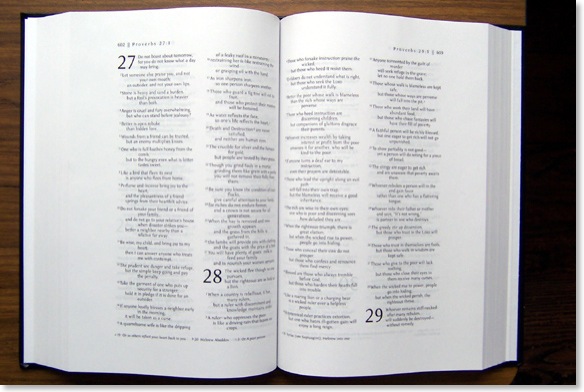
Intrigued, I replied back to the seller asking him to confirm that this was a TNIV and not an NIV Bible and I also asked if there was an ISBN for this item. His response:
Dear Buyer,
There is no ISBN for this particular item. It is however a TNIV. This item was published by Zondervan and the international bible society. It was copyrighted in 2005.
It is apparently a limited edition with this specific book being number 880. We found it in a marketplace in San Antonio and from what I can tell it is pretty rare. It is in like new condition and is a very strong book.
This is incredibly interesting to me that a wide margin TNIV was released for promotional purposes perhaps (?) but never to the general public. Regardless, the Bible pictured above would not meet my needs because there is no writing space next to the inner text which is a must if a wide margin Bible's text is in two columns.
But that brings me around full circle again. If something like the above Bible could be released in a limited run, why not a new printing of such a Bible from Zondervan or IBS. Often certain Bibles from Zondervan will have a "SEA" designation after them in their catalog. This means that it is a limited/seasonal printing that may or may not be printed again after the initial printing is sold out. I do know that there is a single-column TNIV reference Bible in the works (I've seen the proofs). If that particular Bible is not going to be a wide margin, why could there not be a limited run of them produced with wide margins to satisfy those of us who want them and also for the purposes of testing the market?
I know money is always the key issue in such things, but if the BIble pictured above could be produced in limited quantity, why not a single column wide margin TNIV?
Wide Margin TNIV Before the End of the Year? [Updated]

This is very interesting because I have had a number of email conversations with folks from Zondervan who have stated repeatedly that although a wide margin TNIV is not outside the realm of possibilities, there is not one currently planned. From the way the person at Zondervan worded things, it almost sounds as if the Bible is already a project in the works at IBS. Peter was told to contact IBS for further information on the wide margin TNIV, and upon doing just that was told that there was no such listing on the upcoming new TNIV publications through October. However, the person he corresponded with said he would check into it and let Peter know.
Since hearing from Peter, I have also contacted both Zondervan and IBS myself in order to get some kind of clarification. I am currently waiting for a response, but will post on the subject as soon as I hear something.
The case for a wide margin Bible: I have been repeatedly told by more than one publisher that wide margin Bibles simply do not sell as well as other Bibles. However, I find that these editions are indispensable for serious study, and I even like to take notes in a wide margin Bible so that I can use it when I teach or preach. In spite of lackluster sales, I would suggest to the Bible publishers--especially publishers of new translations such as the TNIV--that the users of these kinds of Bibles are influential on the purchasers of other Bibles. An investment into something like a wide margin TNIV might be very beneficial to IBS and Zondervan because teachers and preachers using them can ever more readily recommend them to students and other church members. I've been teaching out of the TNIV for the last few months, but the lack of a wide-margin edition makes me rethink my choice on regular occasion.
Related Reading:
"A Survey of Wide Margin Bibles"
"More Thoughts on Wide Margin Bibles: Here's What I Want"
Update 1/29/07: I believe that a wide margin TNIV will remain elusive as ever for the moment. I'm not so sure that that the information provided to Peter was anything more than miscommunication.
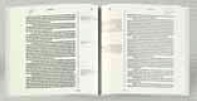
Meanwhile, the sharp eyes of one of our commenters on this post has spotted what is being claimed as a wide margin TNIV on Amazon.com. Two copies are available, both sold by third parties. The Bible is said to be a hardback edition published by IBS, and it carries an ASIN number of "B000MBNJLO" which is odd because I can find no reference to that number anywhere else on the internet. Further, the Bible is said to only be 1144 pages which suggests to me that the print would not be large enough. A decent wide margin Bible is going to have somewhere around 1500 pages. I have emailed both sellers asking about type size and asking for screenshots of a spread.
I'll let you know if I hear anything significant.
NIV Wide-Margins on the Cheap
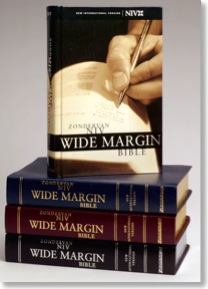
You can even choose which color you want: black, burgundy, or navy blue.
For those of you who like hardbacks, the NIV Wide Margin is only $22.99, although Amazon has it cheaper at $19.79.
Since CBD is known for making exceptional deals on items they often get as remainders, it makes for interesting speculation as to whether or not Zondervan is planning new editions of the NIV Wide Margin Bible. But who knows--maybe they're just overstocked. As I've said before, I'm still holding out for a TNIV Wide Margin Bible. Yesterday, I sent a link to my blog entry on what I want in a wide-margin Bible directly to Zondervan on their contacts page. I also suggested that they look at all the comments on that entry from all of you. So hopefully, they're listening.
Also, a few weeks back I reported that CBD had NLT1 Notemaker's Bibles on the cheap for $17.99. They've now dropped their black and burgundy bonded leather editions down to $12.99 and the hardback is $7.99. Holy frijoles!
More Thoughts on Wide-Margin Bibles: Here's What I Want
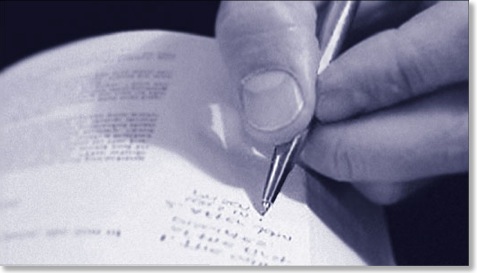
There seems to be a lot of discussion in the blogosphere recently about wide-margin Bibles and Bible note-taking in general.
This will catch you up to speed:
1. A little over a week ago, I wrote a blog entry surveying the current offerings of wide-margin Bibles by various publishers organized by translation. See "A Survey of Wide-Margin BIbles By Version." My goal was to encourage readers to interact with Scripture in a physical way by taking notes in their Bibles. In keeping with my philosophy of "the best Bible is the one that connects to you," I tried to represent as many as translations as possible.
2. In researching that blog entry, I came across J. Mark Bertrand's excellent article on the value of wide-margin BIbles: "Marginal Interest: Why You Need a Wide-Margin Bible." His justification for using wide-margin BIbles was so well-stated, that I merely pointed to his site rather than make my entry any longer than what it already was. See also Bertrand's story about his influence on the ESV Journaling BIble and his post today, "Rolling Justice and Wide Margins."
3. Then, in the comments to my wide-margin survey, Matthew Mansini--a regular This Lamp reader and as it turns out, a connoisseur of wide-margin Bibles--offered an equally worthy description about a number of wide-margin Bible offerings.
4. On a related note, David Lang from Accordance BIble Software chimed in with a question to me regarding my methods of note-taking in Accordance. I embarrassingly admitted that this wasn't one of my habits. I've invited David to write a guest entry for us here describing the process. He's already written two introductory blog entries at the Accordance Blog: "Paper vs. Electronic Note-Taking" and "User Notes: A Personal Example." I will say this, the best justification for electronic note-taking I've heard from David so far came in his comments in the first blog entry where he wrote, "I hate to even mention the possibility of fire to a bibliophile like yourself, but notes in a paper Bible can be just as ephemeral as electronic notes--and they're MUCH harder to back up!" Electronic note-taking may become a habit for me as a way to backup what I've done by hand. Perhaps I will begin to do both at the same time.
5. The ESV Blog has a post today about one Bible Reader's attempt to interleave a blank sheet of paper between each page of his BIble. See "Building Your Own Blank Bible." I seem to remember these kinds of Bibles years ago when I was working in a bookstore. I want to say they were published either by Cambridge or Oxford. Obviously, some folks would prefer this method (although it makes for quite a thick BIble--think TWICE as thick), but my preference is for writing directly on the page, interacting with the text with lines, circles, brackets, highlights, etc.
6. In the upcoming days, look for a blog post here at This Lamp that describes one or two methods/systems for taking notes in a wide-margin BIble.
There are a number of wide-margin offerings out there, but seemingly not near enough. And everyone seems to have a different opinion, but what do YOU want in a wide-margin BIble?
Here's my quick list:
• One column of text. I've never seen a two-column wide-margin Bible where there was ample room for taking notes related to the inner column. The inner column is always cheated because of the binding even when the publisher sees fit to add space on the inside.
• Readable typeface. Minimum of 10 pt.; 11 pt. would be nice. Use normal character spacing as opposed to some of the narrowed text that has been used in Bibles recently to take up less space. Everything about the text should be easy to read.
• Wide margins that are really wide. One and a half to two inches on the outside and one inch at the top, bottom, and inside. If text is one-column, the inside margin is not as big of a deal, but I would at least like a little bit of room for vertical brackets.
• No thinlines! Give us normal paper, not the tissue-like stuff that comes in the average thinline. I want to write in this Bibles without worrying about seeing too much of it on the other side of the page. I don't want the page to curl just because I've written on it and it's too thin. I know that this will be a big BIble, but that's okay. This is not a Bible to stick in a purse! The paper that comes in the Foundation Press single-column NASB or the Zondervan wide-margins are quite adequate in thickness.
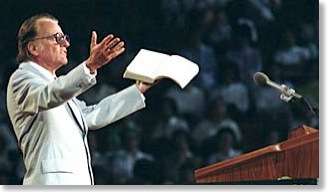
• Quality leather. As this BIble will be intended for use over a long period of time, it should have high quality leather, not just bonded leather like some offerings. Some people prefer hardbacks for writing in, so I suppose a choice in covers would be important.
• Black-letter only. Red-letter Bibles to me are unnecessary as they tend to exalt some words in Scripture above the words of other. It's all God's revelation, so keep it all in the same color. Plus, red text is tiring on the eyes late at night.
• No ruled-lines in the margins. One of the more recently published wide-margin Bibles has tiny ruled lines in the margins for notes. I absolutely don't want these as I like to be creative with my white space. I need the freedom to write vertically if I'm bracketing verses or draw arrows to this and that in the text. Ruled lines would simply restrict my use.
• Regarding the extras. Cross-references outside of those already in the text's normal footnotes are unnecessary. In other words, no columned cross-reference system--this just takes up space that could be used for writing. I may write in my own cross-references or use another source for such. A concordance and maps are nice, but not much else is needed. Perhaps a few blank pages at the beginning, end, and possibly between the testaments would be nice.
These features are what I want in my next wide-margin Bible (I'd really like to see this in a TNIV if Zondervan is listening). Regarding the layout, only Tyndale's Notemaker's Bible and Zondervan's NIV and NASB Wide Margin BIbles have come close to what I describe above (but their bindings leave a little to be desired).
So what do you think? What are your wishes? I know for certain a handful of publishers have dropped by this little blog from time to time. Make your wishes known to them in the comments.
*The graphic of a wide-margin Bible at the beginning of this post was borrowed from the box top for the Zondervan NIV Wide Margin BIble.
A Survey of Wide-Margin Bibles By Version
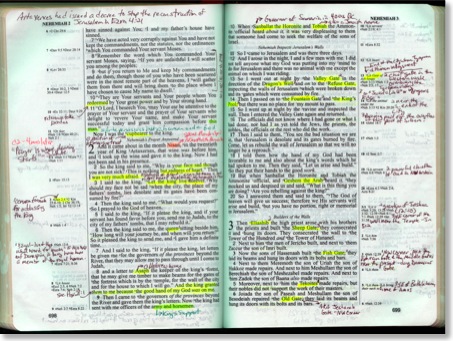
Above: a two-page spread from my NASB Side Column Reference Bible from Foundation Press. Pardon the messy handwriting.
I've always made the suggestion to my students to read the Bible daily, and study the Bible one to two times a week. To me there's a difference between the two. Perhaps in a future blog entry, I'll give greater delineation, but for right now let me suggest that real study of the Bible will include taking notes, and for me, I enjoy writing the most significant information directly into my Bible. I find my own habits humorous, but difficult to break. Perhaps it goes back to that overly exalted view of the physical Bible, but I find myself writing in my Greek New Testament only with a pencil. Usually these marks are of a textual or grammatical nature. Or sometimes I write in an English gloss for a very obscure Greek word. However, in my wide-margin NASB, I write in a multitude of ink colors and dry highlighters (I'll have to soon blog separately about my marking system, too). The notes in my English translation range from background information, underlying Greek or Hebrew wording, commentary, my own thoughts and reflections and profound quotations picked up here or there that seem to go with the text. Perhaps I'm more conservative to the Greek text because it's nearer in my mind to those actual autographs. I don't know, but my system is working for me.
My current habit is to study a passage of Scripture making the appropriate notes in my Greek New Testament and a wide-margin NASB from Foundation Publications. I prefer a more formal, literal translation for my notes, but I'm not saying that you have to do the same. I have a second wide-margin that I'm also using these days. Since our Sunday School literature uses the Holman Christian Standard Bible (and because I really like this translation), I have a copy of the HCSB Minister's Bible that I take with me on Sunday mornings to church. Since it's margins are smaller, and because I don't need everything I've noted anyway, I copy a subset of notes into my HCSB. Again, this is a system that is working for me.
I know that for some, it's very hard to start writing in the margins of your Bible if you grew up with the same mindset that I did. But I can testify to you, that I've never once accidentally mistaken one of my notes, written in the margin, as actual Scripture. And if you saw my handwriting, you'd agree that there's no chance of making that kind of mistake. I encourage everyone to make a habit of taking notes in your BIble. You will be amazed at how your Bible study is enhanced and how much those notes will come in handy at a near or later date. For even more encouragement on this subject, I would direct you to a blog entry by J. Mark Bertrand, entitled "Marginal Interest: Why You Need a Wide-Margin Bible."
In light of my encouragement to you to use a wide-margin Bible for personal study (in the translation of your choice), I have made a search on the internet for available wide-margin editions and grouped them according to translation (listed alphabetically). Below, I've tried to comment on these Bibles giving you the positive and negatives. I am not going to comment on extra features in a particular Bible such as the minister's helps in the HCSB Minister's Bible as that is not relevant to this blog entry topic. I have examined most of these Bibles by hand and I personally own two of them. Rather than linking to a particular outlet like Amazon.com, I am instead giving you the ISBN for each particular publication. All you need to do to find a supplier is to search for an individual ISBN in Google or your preferred search engine. You can also take these ISBNs and search for them directly on a site like Amazon.com or Christianbook.com or even give the number to a local merchant for ordering.
English Standard Version (ESV)
I'll hand it to Crossway for coming up with a number of really nice bindings that combine a traditional look and feel with quality materials. There are essentially two ESV Bibles with wide-margins.
Deluxe Reference Edition
These Bibles feature a traditional two-column text with a center column reference. Margins for taking notes are slightly less than one inch. The premium calfskin edition is one of the nicest (but also most expensive) ESV Bibles money can buy. Nitpicks: Top and bottom margins are not wide and therefore not suitable for much note-taking. Also the inner margins will not give you as much room for notes simply because of the binding itself.
Hardcover: 1581344368
Bonded Leather: 1581344384
Premium Calfskin: 1581343507
Journaling Bible
This edition of the ESV Bible is a fairly new release from Crossway and has received lots of attention. I really like the concept of this Bible, but I have a number of problems with the final product. Regardless, there's a lot to like here. The ESV Journaling Bible looks like something out of the Moleskine Catalog. It's hand-sized as a change of pace from many wide margin Bible and has a generous two inches of note space at the edges of the page. It has a two-column layout with center-column cross references. The paper is off-white, giving it an antique look in keeping with its moleskine design. The outer cover of the less-expensive edition (I haven't handled the calfskin leather one) is a padded hardback with an elastic strap (again in moleskine fashion) to keep it closed when not in use. I initially read in one review on the internet that it opens flat, even at Genesis 1, and while in a bookstore recently I confirmed that to be true. The price is also right for this Bible. I've seen it as low as $17.99 at a couple of websites. Nitpicks: I haven't heard anyone say a positive word about the size of the print. It's a tiny 7.5 type, the size in your average compact Bible. This is way too small to be useful as a note-taking Bible in my opinion, in spite of my attraction to the compact size. I think you just can't easily have both. Also, while I generally prefer a one-column text layout over two columns, if there are two columns in a Bible designed to take notes, it's imperative to have space next to the inner column. Otherwise, it's hard to designate notes for the inner column. And this is just me, but I would prefer no ruled lines since I often bracket verses and even write vertical headings. Perhaps Crossway is making a distinction between a Bible to journal one's thoughts in as opposed to a Bible to write notes in. I don't know. Regardless, as I said, I really like the concept of this Bible, but until another edition comes out that addresses some of the above concerns, I would have to recommend the Deluxe Reference Edition as a note-taking Bible to the person partial to the ESV.
Original (Elastic Strap): 158134838X
Calfskin Leather: 1581348398
Holman Christian Standard Bible
To my knowledge, there is currently only one wide-margin HCSB Bible available as of this writing, but I would hope that there will be more coming as this translation is still fairly new.
Holman CSB Minister's Bible
The HCSB Minister's Bible has a nice single-column text that is at a decent 9.5 pt. typeface in a text layout that feels neither crowded or rushed. The one-inch margins are at the outer edge, top and bottom of the page, but not in the center of the spread. The text has only black typeface (which I prefer), and the quality of the leather is good with raised ribs on the spine adding a nice touch. This is the Bible I teach out of on Sunday mornings. Nitpicks: The paper in this Bible is too thin. In an attempt to create a Bible suitable for taking into the pulpit, B&H made this Bible a quasi-thinline by using thinner paper. When you write on a page, the paper will curl. Closing the Bible for a while corrects this curling, but it can be annoying while you are using it. Personally I believe the sweet spot for a wide margin Bible is one and a half inches, not one inch alone. In poetic and prophetic sections, there is ample room for notes. But in prose sections such as the gospels or the epistles, there really isn't adequate room to write extensive notes. I can't imagine a pastor trying to copy his outline in these margins. Also, for the person who does not consider himself (or herself, as the case may be) a minister, the title on the spine may be a bit disconcerting.
Black Leather: 1586401696
New American Standard Bible
There have been a variety of NASB wide-margin Bibles along the years in both the original 1977 edition and the updated 1995 edition. Currently, I cannot find a single-column NASB text that is also in paragraph format.
NASB Side-Column Reference Wide Margin (Foundation Publications)
I use this Bible myself. The paper is thicker than that in many of the Bibles on the market today which is helpful for reducing bleedthrough. The outer edges sport a one-inch margin but the nature of the side-colmn references often allow for another inch of space (see the scan of my copy above) for passages with fewer cross-references. Regardless of the debate about verse-by-verse format vs. paragraphs, the nature of the individual treatment of the verses allows the user to add notes above and below verses in some cases.This Bible will lay flat immediately, and the bindings of all Foundation Press Bibles is usually well above par. Nitpicks: There seems to be less room in the 1995 update than in the previous 1977 edition. There used to be more space between chapters and at the beginning of books of the Bible. This newer edition feels a bit cramped at times. If you prefer passages in paragraph format, you will be disappointed in all of the wide-margin NASB Bibles, not just this one. I could also do without the vertical line between the cross-references and the text.
Blue Hardcover: 0910618461
Burgundy Bonded Leather: 091061847X
Black Bonded Leather: 0910618488
Burgundy Genuine Leather: 0910618496
Black Genuine Leather: 1885217668
Blue Genuine Leather: 188521796X
Blue Genuine Leather Thumb-Indexed: 1581350384
Burgundy Genuine Leather Thumb-Indexed: 188521782X
Black Calfskin: 1581351127
Burgundy Calfskin: 1581351135
Blue Calfskin: 1581351143
Zondervan NASB Wide Margin Bible
There's very little not to like in this Bible. The most impressive feature is the two-inch outer edge margin. There is lots of extra space at the beginning of books and an incredible amount of space for writing in poetic sections. The pages are thick enough not to easily bleed through. Nitpicks: Very minor really. Personally, I like the cross references in the Foundation Press NASB Bibles, but if this is not an issue to you, the greater space for notes is to your advantage. the type-size is at an 8.8 slightly smaller than some wide-margin Bibles. I recommend viewing the print in a store before buying this Bible and subjecting weak eyes to hours of staring at the text. I might also wonder how these bindings hold up after a few years' worth of use. There is nothing above a bonded leather grade available.
Hardcover: 0310921848
Burgundy Bonded Leather: 0310921856
Black Bonded Leather: 0310921864
The New Inductive Study Bible
Fans of Kay Arthur's Precept Bible study methods will appreciate this wide margin edition of the NASB. However, I have also personally known individuals who bought it simply for its large typeface and one inch margins. This is a large Bible with thicker paper than some Bibles, specifically designed to be written in. Nitpicks: Often the margins will be filled with study helps completely obscuring the area for writing in your own notes. Unless you're a Precept student, I would recommend buying one of the other Bibles listed here.
Hardcover: 0736900160
Hardcover Thumb-Indexed: 0736900225
Burgundy Bonded Leather: 0736900179
Burgundy Bonded Leather Thumb-Indexed: 0736900233
Burgundy Genuine Leather: 0736900187
Burgundy Genuine Leather Thumb-Indexed 0736900241
In Touch Ministries Wide Margin Edition
The margins go around the entire two columns of text with these dimensions: 1.25 inch outter margin, bottom, 1.30 top, 0.75 inch inner margin. The differences between this bible and the side-column wide margin is that there are no references or translation notes in the margin space leaving more space to write. The In Touch edition is not branded by Charles Stanley, but merely has an Introductory note from him, right after your presentation page. He isn't even on the copyright page, which informs you that this is a Note Taker's edition of the NASB. This edition has a 10.5 pt. typeface. Nitpicks: The inside margin is too narrow to be usable.
Hardcover: 1581350732
Burgundy Genuine Leather: 1581350686
Burgundy Calfskin: 1581350708
Black Calfskin: 1581350716
Blue Calfskin: 1581350724
New International Version
I know of three wide-margin editions of the NIV. If you know of others, please let me know.
Cambridge NIV Wide Margin
If you prefer your text in two columns, Cambridge wide-margin editions are better than anything else you'll find. They really get this right. Many of these editions are more expensive than what you'd pay for other bindings, but you get what you pay for because the quality is matched by just about no one else. One reason why Cambridge gets these editions right is because the margins (over an inch) go all the way around the two columns of text, including the inside of the page. Nitpicks: None of any real significance. The only detractor is the cost, but note that an edition is available in imitation leather at a very affordable price.
Black Imitation Leather: 052160334X
Burgundy Bonded Leather: 052150869X
Black Calfskin Leather: 0521508797
Black Goatskin Leather: 0521691206
NIV New Inductive Study Bible
See description of NASB edition above. The only difference in the NIV edition is paragraph format for verses.
Hardcover Thumb-Indexed: 0736900225
Bonded Leather Thumb-Indexed: 0736900233
Genuine Leather Thumb-Indexed: 0736900241
Zondervan NIV Wide Margin Bible
Single-column text--for a complete description see the Zondervan NASB Wide Margin Bible above. The only difference in the editions is the paragraph format of the NIV Wide Margin.
Hardcover: 0310922143
Black Bonded Leather: 0310922151
Navy Bonded Leather: 031092216X
Burgundy Bonded Leather: 0310922178
New King James Version
There's only one NKJV Bible to my knowledge, and it may be out of print.
Holy Bible Wide Margin Center-Column Reference Edition
I have not actually seen one of these Bibles firsthand. The Thomas Nelson website seems to indicate they are in print, but Amazon does not offer anything but used purchases. Regardless, they are the only wide-margin NKJV's I can find. The TN site describes them as "Printed on heavy paper to lessen 'show-through' from ink or pencil inscriptions, each page has a wide margin completely surrounding the text. Center-column references and translation notes open doors to in-depth Bible study." Obviously, these are two-column Bibles, and from what I read at Amazon.com, the margins are one-inch and includes the inside of the page. Nitpicks: Reading the comments at Amazon, I gathered that the paper might not be as thick as what the TN description describes. However, I would never recommend using any pen but a ballpoint anyway to avoid bleedthrough. There was also a comment suggesting the the top margin was more narrow than the other margins.
Hardcover: 0840728905
Burgundy Genuine Leather: 0840728948
Black Genuine Leather: 0840728921
New Living Translation
There are currently no NLT wide-margin Bibles in print, and I have confirmed this with Tyndale. However, an out-of-print edition that I mentioned in a blog entry the other day can still be obtained at very reduced prices, so I am going to list these here for reference. Note that these are only available in the first edition NLT (1996), not the second edition (2004).
NLT Notemaker's Bible
I have to say up front that the layout in the NLT Notemaker's Bible may be the best layout of any wide-margin Bible in my opinion. This Bible has a generous 1 1/2" margin on the sides for notes and an incredible two inches of lined space at the bottom for journaling. The text is in a single-column format (which I prefer for a wide-margin Bible) and I don't know the exact type-size, but it's definitely larger than your average reference Bible and easy on the eyes. The pages are also thick enough that reasonable note-taking shouldn't bleed through. Words of Christ are in black (which I prefer). If you prefer leather over hardback, Tyndale has really improved the quality of their leather--even bonded leather--in recent years, and the Notemaker's Bible is no exception. This is a quality-made Bible that will last a long time. Nitpicks: These are obvious--this edition is out of print and only available in NLT1. I wish other publishers would take note (pun intended) and apply a similar layout to other translations. Some might object to the ruled lines at the bottom, but the space between the lines is more generous than that in the ESV Journaling Bible, so that might not be a problem. Be sure to check Christian Book Distributors for extremely low prices while supplies last.
Hardcover: 0842375724
Black Bonded Leather: 0842375732
Burgundy Bonded Leather: 0842375740
New Revised Standard Version
To my knowledge, there are no wide-margin NRSV Bibles currently in print. For a while, Cambridge published a wide-margin NRSV, and I am offering those ISBN's below as they can still be obtained used.
Cambridge NRSV Wide Margin Bible
Presumably, these Bibles would have a similar layout to the Cambridge NIV Wide Margin that I described above. Please see that description above for more details.
Hardcover: 0521507790
Burgundy Bonded Leather: 0521508436
Today's New International Version
The TNIV is the newest translation in this survey, and there aren't too many choices yet. I would like to see Zondervan publish an edition of the TNIV similar to their wide-margin NIV and NASB offerings. I assume that such editions will be available in the future.
TNIV Thinline, Square (TNIV Thinline Bible2)
These Bibles are just what they say they are--they're square. Zondervan has taken a TNIV Thinline Bible and added about an inch and a half to the outer margins for the purposes of note-taking or journaling. Nitpicks: I have the same criticism of this Bible that I have for many two-column wide-margins--there's no room for taking notes on the inside of the page to relate to the inside column of text! There's also a thin vertical line between the text and the outer margin that might get in the way if you take notes like I do with lots of lines and arrows. The paper is really too thin to use this Bible longterm for notes (in my opinion, thinline Bibles don't make good note-taking Bibles). Personally, I'm not wild about any of the covers of these Bibles, but I suppose that's off-topic.
Italian Duo-Tone, Dark Burgundy/Pale Blue/Brown: 0310934990
Italian Duo-Tone, Dark Burgundy/Tan: 0310935008
Italian Duo-Tone, Bright Pink/Melon Green: 0310935016
Italian Duo-Tone, Meadow Green/Melon Green: 0310935024
Questions? Thoughts? Comments? Rebuttals?
Some of this information is incomplete. If you have a correction or know information I don’t, please let me know and I will add it to this entry. Here are some questions that I could foresee some folks having:
What about original language texts?
I do not know of any Greek or Hebrew texts with wide margins. There used to be a 26th Edition Nestle-Aland Greek New Testament with a wide-margin, but I do not know the ISBN. Personally, for taking notes in a Greek New Testament or Hebrew Bible, I recommend that you use the larger print editions (which I use myself):
Large Print NA 27: ISBN 3438051036
Large Print (technically the standard edition) BHS: ISBN 3438052180
What about the KJV or the Message?
I don’t know of any wide-margin editions of the Message, but I didn’t look. Also, Cambridge has a nice selection of wide-margin KJV Bibles in a similar layout to the Cambridge NIV Wide Margin Bible I described above. I did not include either of these translations in my survey because I personally don’t recommend either for serious study, although they have other value.
What about the CEV? GNT? NCV? GWT? NAB? NJB? RSV? REB? Or my other favorite translations?
As far as I know, there aren’t any wide-margin editions available for these translations. If you know of one, please send me a description and I’ll amend this blog entry.
Redacted 10:30 PM. Special thanks to Matthew Mansini for his information regarding the NASB In-Touch Ministries Edition. be sure to read his additional insights regarding wide-margin Bibles in the comments.
A Journaling Greek New Testament?
In the comments from yesterday's post William Turner asked some very good questions relating to original language texts, especially the availability of wide-margin Greek and Hebrew texts. As I began answering him in the comments, I decided that others might be interested as well, and perhaps some of you could even help me answer his questions. I'll place William's questions and comments in bold and my answers will follow.
Do you know of anything like this for Greek or Hebrew? I know that UBS has A Reader's Greek New Testament but the paper is thin, the margins aren't really wide and there is vocab stuffed at the bottom. I guess what I am looking for it a Journaling GNT. I do have a really old (pre 20th century) two volume Hebrew Bible that has a blank page and then a text page, etc. So you always have one blank page to write notes. I am unaware of anything for Greek.
First, a word about A Reader's Greek New Testament: This Greek New Testament is actually from Zondervan, not United Bible Societies (UBS) and represents the Greek text underlying the New International Version (and perhaps the TNIV?). According to its introduction, it differs "from the standard text at 231 places" (p. 10). I have never taken the time to compare these differences from the Nestle-Aland (NA) text, but I can't imagine they would be of great significance. However, it is significant that we now have an alternative Greek text (besides something like Farstad's Majority Text NT) to the commonly used USB or NA texts (which are identical). Of course, if we think there is confusion now with so much choice in Bible translations, I wonder what it will be like if we begin to have a number of competing Greek texts? Over the years I've heard concerns as to what will happen to future editions of the standard Greek text once Bruce Metzger passes away and it is controlled by less conservative hands. Will we then start to see competing evangelical Greek New Testaments? It's an intriguing thought, but personally I hope not. It's regrettable that we can't agree on a standard translation anymore (yes, I find that regrettable, believe it or not), but I really don't want a multiplicity of original language texts, too.
Having said all that, I have a copy of A Reader's Greek New Testament and I carry it in my book bag to church on Sundays. Since it includes the vocabulary of all words that occur 30 times or less, it's quite handy for quick reference. I don't teach from it, but I use it to occasionally satisfy my own curiosity during the pastor's sermon or answer a question when I am teaching Sunday School. But, you're right, William; it does not really have enough space to take notes. And the text itself is in italics (like the UBS4), and in my opinion, that makes it harder to read. Nevertheless, it's good for what it does.
Now, to specifically answer your question... What I really recommend and like to use myself are the large print versions of the NA27 (ISBN 3438051036) and BHS (ISBN 3438052180). It seems that when the average person goes to buy an original language text for the first time, he or she is usually steered to one of the hand-size editions. In fact, these are the only editions most stores carry (if they carry such things at all).
The large print NA27 has about a half inch margin at the page's edge and a full inch at the bottom. There's even more room at the page's edge for texts that aren't over-burdened by cross-references. Plus there's just enough room between the lines of the Greek text that I can make tight notes above or below particular words. I've even known those who have taken one of these editions and written in the definitions of all words that occur ten times or less in the Greek text. There's enough room on the page that you could realistically do this.
The large print BHS (technically the standard size, actually) carries the same height and width dimensions as the large print NA27, but obviously much thicker. But because the are the same size, they nicely stand beside each other on a bookshelf. The BHS does not have margins as generous as the NA27, but there is still plenty of room to make notes between lines of text (if you can write small), and of course in poetic writings there's ample space. Although I might use pens and even dry highlighters in translations, I tend to only use a pencil for notes in my Greek and Hebrew texts. A sharpened lead or a mechanical pencil is perfect for fitting notes in tight places.
Incidentally, I have seen one professor who had both of these large print editions professionally bound together, like the hand-size Biblia Sacra, but it makes for too thick of a book in my opinion to recommend that.
Having said all that, there actually used to be a true wide-margin Nestle-Aland Greek New Testament. Basically, it was printed from the plates of the standard hand-size edition, but on the same-sized paper found in the large print. I'm almost positive this edition is no longer in print, and I've never seen anything more recent than the 26th edition of the NA in wide-margin anyway. While the margins weren't as wide as something like the ESV Journaling Bible, there was still plenty of room for lots of notations. Such things are the stuff of legends, but I've heard it told that decades ago when John Polhill was studying for his doctoral comprehensive final in Greek, he took a wide-margin Greek New Testament, and worked through all 27 NT books rendering his translation in the margins in just a few short months.
Perhaps someone reading this can provide an ISBN for the wide-margin NA26 or provide information about a newer edition if there is one in print. There are a variety of Greek texts available, but the descriptions at the ABS website are scant.
I made up a three column version with WORD for Rev. 1 in Greek, but it is a hassle to make. I am going to try it out in translating and see how it works. I have a smaller column on the left for notes on words then the middle column is the actual Greek text and then I have a third column for the actual translation.
When you translate do you have a specific method? That would be a good blog post by the way - I at least would be very interested in others translating habits.
I've often toyed around with the idea of making my own Greek New Testament and having it professionally bound. I have access to the entire Greek text in software and my laser printer features duplex printing capabilities, so while it would be time-consuming to set up, I certainly have the tools necessary. I'm certain that reproducing that much of the text would probably fall outside copyright limitations, but since it would be only for my own personal use, I could probably live with the guilt
William, I like your three-column layout and have used similar methods. I'll be honest that most of the time now when I translate for my own purposes, I simply use my Greek New Testament and a notebook. Nothing very fancy at all, but I do like to use a notebook because I want to keep what I've done. I know some guys swear by the need for diagramming--and I've done it before--but I'm too lazy to do it every time I translate (and frankly I don't feel I need to).
Now, when I was preparing translations for classes, I finally settled into a system similar to your three-column method. I would copy the text from a program like Accordance and then dump it into my word processor. I always liked to work with my page in landscape. I would create about an inch or more between every line of text and then leave about a three inch margin on the right. After printing it out, the space between my lines of text was enough room (using sharp lead or a mechanical pencil) to include parsing information and my own gloss. Then I would use the margin on the right to smooth out my final translation. Here's a link to an Adobe PDF file that shows Colossians 1-2 prepared in this format: Col 1-2
Sometimes I still make translation sheets like this when I'm doing serious work. My methods have never been too elaborate. I'd be interested in hearing from others as to their translation methods. I read somewhere that if you translate about 22 verses a day, you will translate the entire Greek NT in a year's time. I don't actually have time to translate that many verses everyday (I'm not yet fast enough!), but a while back I decided to try to do about ten verses a day. I figured this was a good way to stay fresh (since I'm no longer taking classes) and build my vocabulary at the same time. Granted, there are days I miss altogether, but it would be nice to translate completely through in say, three years.
What do some of you do? How do you keep your Greek (and/or Hebrew) fresh? Do you have translation goals? If so, what are they?
Also please post in the comments if you know of a particular wide-margin Greek or Hebrew text, or tell us if you have made your own text.
Heads-Up: NLT Wide-Margins on the Cheap
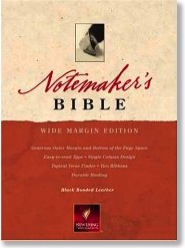
Personally, when it comes to Bibles, I'm a huge fan of generous wide-margins for taking notes. I would rather create my own notes through personal study than carry someone else's notes with me. Currently, I use a wide-margin NASB for personal study notes and wide-margin a HCSB for teaching notes. It's worth mentioning that a couple of weeks ago Crossway released a really nice edition of the ESV called the Journaling Bible which gives abundant space for notes (if you don't mind the tiny 7 pt print).
Sometime soon, I think I'll write a blog entry detailing the current offerings of wide-margin Bibles, organized by translation. In the meantime, I should mention to you fans of the New Living Translation (first edition) that Christian Book Distributors currently has a great deal on what I would assume to be close-out copies of The Notemaker's Bible: Wide-Margin Edition. You can even choose between black bonded leather ($14.99 instead of the regular $49.99), burgundy bonded leather (also $14.99 instead of $49.99) and the hardback at an incredible $7.99 (down from $24.99). At those prices, even if you merely wanted a copy of the NLT1 for reference, this would be a good choice. It also makes a great choice as a backup if you prefer the NLT1 over the NLT2.
If you've never seen Tyndale NLT Notemaker's Bible, I can tell you that it's really nice. In fact, I would dare say, it's one of the nicest wide-margin Bibles I've ever seen. One of my former students carried one regularly and so I've seen one firsthand. I wish I had a page spread to show you here, but I cannot find one online. However, the Notemaker's Bible has a generous 1 1/2" margin on the sides for notes and an incredible two inches of lined space at the bottom for journaling. The text is in a single-column format (which I prefer for a wide-margin Bible) and I don't know the exact type-size, but it's definitely larger than your average reference Bible and easy on the eyes. The pages are also thick enough that reasonable note-taking shouldn't bleed through. Words of Christ are in black (which I prefer). If you prefer leather over hardback, Tyndale has really improved the quality of their leather--even bonded leather--in recent years, and the Notemaker's Bible is no exception. This is a quality-made Bible that will last a long time.
Currently, there are no wide-margin editions available for the second edition of the NLT.
And before you ask, no--neither Tyndale, nor CBD sends me any royalties! I just thought this was a really good deal and figured I'd share it.










